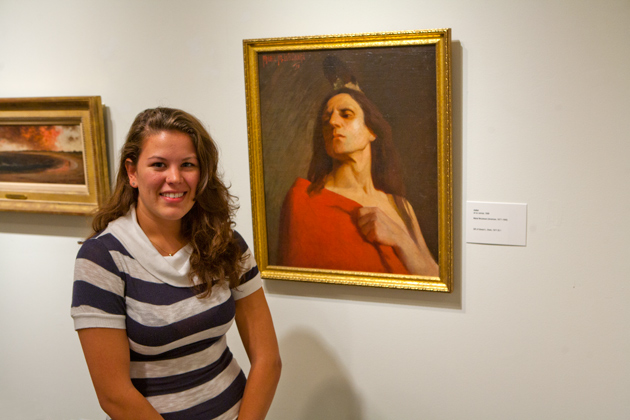
Students taking a class in 19th-century American art with Alexis Boylan have the opportunity to view works of art up close at the William Benton Museum of Art.
“I always prefer when students can work from original pieces of art,” says Boylan, an assistant professor-in-residence with a joint appointment in women’s studies and art and art history.
Over the summer, she worked with the Benton’s staff to select works for the class from the museum’s collection, and the resulting exhibition was on display in the museum’s Center Gallery for a month at the beginning of this semester. Most of the items were paintings and prints, and the artists included big names like Winslow Homer, as well as local luminaries like Ellen Emmet Rand.
Thomas Bruhn, interim director of the Benton, says the museum has produced exhibitions at professors’ requests for a decade. He says students’ writing skills can improve when they have the opportunity to view the objects they are writing about over an extended period. This semester the Benton is staging four exhibitions at the urging of various fine arts professors. On other occasions, faculty in history, languages, and nursing have solicited exhibitions.

This is the second year the Benton has supported Boylan’s class by displaying specially selected works from a collection she describes as ‘diverse’ and ‘exciting.’ She says that objects viewed in books and on slides are often distorted.
Rosemary Cann ’12 (SFA), a printmaking major in Boylan’s class says, “There’s a drastic difference between seeing objects online and seeing them in person as they’re meant to be experienced.”
Kevin Solorzano ’12 (SFA), an art history major, also appreciates the opportunity to study original works of art. He says one of the reasons he chose UConn is because the museum is on campus.

Students in the class, which carries the ‘W’ designation for its strong writing component, are each assigned one of the works in the exhibition to study for the duration of the course. They research the work, and are also encouraged to make original contributions in a 12-page paper about it. Every two weeks, the students hand in drafts, and they also review the work of their peers.
“It can be demoralizing for students to compare their work with that of professional academics and writers,” Boylan says, “but it’s enlightening to see what your peers are producing.”
She says that such intensive study of a single work of art challenges the students. “Inevitably, students hate and love their object when they work on it all semester,” she says. “Each has its own trial and tribulation in terms of a 12-page paper.”
Cann says it’s worth it. “I want 110 percent to take my second ‘W’ in art history because it’s such an enriching process for thinking about art. Writing has a different effect upon the way we learn to think – more than by just taking notes or listening to a lecture.”

Alysha Elliard ’13 (SFA), a photography major who was assigned Indian, an oil on canvas painted by Mabel Woodward in 1899, also welcomes the challenge. “I’m busy, and on my own I’d pick something super easy,” she says. “Now, I’ll stare at my painting for 10 minutes, hoping it will say something to me. This makes me think about what I’m doing more than if I were just able to pick my object.”
Boylan says that for some of the pieces, there aren’t a lot of pre-existing materials to research, but the ultimate goal is for students to make an original contribution. “Last time I taught this class, there were a number of papers that I thought discovered new and intellectual connections about the objects,” she says. “I’ll expect nothing less of this group.”
Because of its intensive focus on improving writing skills, Boylan’s class is capped at 19, with some seats reserved for art majors.
Justine Braisted ’13 (SFA) was assigned an oil on canvas, Rye Beach, New Hampshire, painted by Martin Johnson Heade in 1863. She says she initially didn’t see a connection between her very technology-based graphic design major and a painting done the year that Abraham Lincoln signed the Emancipation Proclamation. But she says her artistic perceptions have grown because of the class.
“The skills we’re using to interpret these pieces are totally universal, related to graphic design, illustration, and painting,” Braisted says. “Now I know how to analyze a piece no matter what medium it’s in.”
Boylan designed the class to foster just such transformative critical thinking. “When these students leave college they will have learned skills that are a jumping-off point,” she says, “and they won’t be locked into just one profession.”



